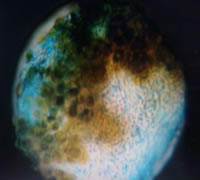What's so important about this name?
Trebouxia erici is the photobiont of the British Soldier Lichen. That means this is the organism that helps provide the fungal side of this organism with many of its nutrients. Since fungi cannot photosynthesize, they usually rely on heterotrophic means of acquiring nutrients. Through this symbiotic relationship however, Cladonia cristatella does not have to rely solely on detritivorous means of obtaining nutrients.
The image above is a photo taken of a Trebouxia species within another unnamed lichen species. The darker circles are the algae, whereas the lighter areas are the cortex regions of the fungal mycobiont.
So, how is Trebouxia erici classified?
Domain: Eukarya
Kingdom: Viridiplantae
Phylum: Chlorophyta
Class: Trebouxiophyceae
Order: Microthamniales
Genus: Trebouxia
Species: erici
So, why do we classify this algal species the way we do?
Eukarya: As stated in the section regarding Cladonia cristatella, membrane bound organelles and a nucleus must be present. They also have a much more complicated internal cellular structure and package their DNA into chromosomes rather than plasmids.
Viridiplantae: This literally means "green plants." Think viridi or verde, which means green, and plantae which sounds suspiciously similar to plant. These are photosynthetic organisms that contain chloroplasts and chlorophyll. Besides photosynthesis, the absence of class I myosins is another way to differentiate this kingdom from another. Class I myosins are used for actin based motility. If you've ever moved a limb on your body, then actin based motility is likely the mechanism.
Chlorophyta: These are also known as green algae. Like land plants, these contain two types of chlorophyll, chlorophyll a and chlorophyll b. Many exist freely or as symbionts with algae or fungi. In the case of our organism of interest, its a fungus.
Trebouxiophyceae: There is not much listed on this class. Due to recent molecular research, there is talk of revising the taxonomy of this organism all together! This is a very vague class that was created in the mid-1990s and taxinomic research is still ongoing.
Microthamniales: One study conducted in the mid-1990's examined the relationships between Microthamniales and other green algae species utilizing molecular techniques to compare ribosomal RNA (rRNA). This order possesses a unique 18s rRNA that can differentiate it from other orders. Morphology has proven to be insufficient to taxonomically categorize these organisms at this level. By performing a polymerase chain reaction (PCR) the sequences of this RNA were amplified and observed using various molecular techniques. In this experiment, a Dynabead-M280 protocol was performed. These beads bind to the RNA fragments prior to sequencing. Solid phase sequencing then revealed the similarities and differences at the molecular level.
Trebouxia: This is considered to be a paraphyletic in regards to rRNA sequences. This means that a common ancestor has not yet been identified. With ongoing molecular research however, this is likely to change. As of now, approximately 20% of all lichen species contain a form of Trebouxia. There is talk of reclassifying some of these organisms as an entirely new genus all together called Asterocholores, since significant amounts of molecular evidence suggests dissimilarities within the group. Our photobiont, T.erici is currently being considered for a name change due to molecular evidence. This genus contains both free living organisms as well as those living in symbiosis with fungi.
erici: This is the species name of our organism. This organism exists solely as a symbiont within lichens and is not found elsewhere. This photobiont provides energy to the fungus through photosynthesis and production of glucose while the fungus provides shelter. Without the symbiotic relationship that exists within lichens, the fungus would likely have a more difficult time surviving while the algae would not be able to colonize certain areas due to the lack of adequate water.
